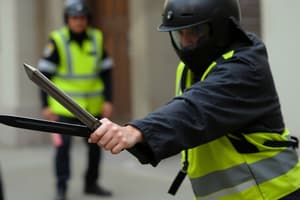Podcast
Questions and Answers
What is the purpose of using loud verbal commands during a defensive technique against an edged weapon?
What is the purpose of using loud verbal commands during a defensive technique against an edged weapon?
- To distract the attacker
- To request help from bystanders
- To assert control and communicate intention (correct)
- To signal a surrender
What is the initial action one should take when evading an attack from an edged weapon?
What is the initial action one should take when evading an attack from an edged weapon?
- Circle towards the attacker
- Pivot backward to evade the forward movement (correct)
- Stand still to assess the situation
- Run directly away from the attacker
Which technique is used to create distance between you and the weapon during a defensive maneuver?
Which technique is used to create distance between you and the weapon during a defensive maneuver?
- Pushing the attacker away
- Jumping sideways
- Slapping the attacker's arm or shoulder (correct)
- Striking the attacker's knee
During redirection technique 2, what should you do with the subject's right arm?
During redirection technique 2, what should you do with the subject's right arm?
What is the last step in the described redirection technique 1?
What is the last step in the described redirection technique 1?
What should be maintained while applying downward pressure to the elbow during redirection technique 2?
What should be maintained while applying downward pressure to the elbow during redirection technique 2?
Why is it recommended to circle or angle away from the attacker during an edged weapon attack?
Why is it recommended to circle or angle away from the attacker during an edged weapon attack?
In redirection technique 1, after pushing the attacker's arm, what should you do next?
In redirection technique 1, after pushing the attacker's arm, what should you do next?
What is the best course of action when facing an edged-weapon attack from a distance?
What is the best course of action when facing an edged-weapon attack from a distance?
What should be your first priority when an edged weapon attack happens suddenly and closely?
What should be your first priority when an edged weapon attack happens suddenly and closely?
What is the minimum safe distance necessary to reduce the risk of injury from an edged-weapon attack?
What is the minimum safe distance necessary to reduce the risk of injury from an edged-weapon attack?
Which of the following is a recommended defensive movement against a close-quarter edged-weapon attack?
Which of the following is a recommended defensive movement against a close-quarter edged-weapon attack?
What mental preparation should one develop when anticipating an edged-weapon attack?
What mental preparation should one develop when anticipating an edged-weapon attack?
What common knife attack pattern involves a direct motion towards the target?
What common knife attack pattern involves a direct motion towards the target?
Which of the following tactics is NOT advised when responding to an edged-weapon attack?
Which of the following tactics is NOT advised when responding to an edged-weapon attack?
What is a key advantage of using obstacles during a close encounter with an edged weapon?
What is a key advantage of using obstacles during a close encounter with an edged weapon?
Flashcards
Edged Weapon Defense
Edged Weapon Defense
Techniques used to protect oneself from attacks involving edged weapons like knives.
Deadly Force
Deadly Force
The use of force likely to cause death or serious bodily harm, sometimes needed when confronting edged weapons.
Minimum Safe Distance (Edged Weapon)
Minimum Safe Distance (Edged Weapon)
The recommended distance of approximately 25 feet to effectively react to an edged-weapon attack without injury.
Survival Mindset
Survival Mindset
Signup and view all the flashcards
Knife Attack Patterns
Knife Attack Patterns
Signup and view all the flashcards
Evading
Evading
Signup and view all the flashcards
Redirect Technique
Redirect Technique
Signup and view all the flashcards
Early Recognition
Early Recognition
Signup and view all the flashcards
Redirection Technique
Redirection Technique
Signup and view all the flashcards
Redirection Technique (1)
Redirection Technique (1)
Signup and view all the flashcards
Redirection Technique (2)
Redirection Technique (2)
Signup and view all the flashcards
Evasion
Evasion
Signup and view all the flashcards
Verbal Commands
Verbal Commands
Signup and view all the flashcards
Weapon Arm Control
Weapon Arm Control
Signup and view all the flashcards
Edged Weapon Defense
Edged Weapon Defense
Signup and view all the flashcards
Force Options
Force Options
Signup and view all the flashcards
Study Notes
Defense Against Edged Weapons
- Lesson Goal: Demonstrate defense against an attacker using an edged weapon.
- Knife Fighting: A sophisticated technique, this lesson provides basic knowledge only.
- Deadly Force Response: Defense against edged weapons, bottles, clubs, or blunt instruments might require a deadly force response.
- Empty-Hand Techniques: Use empty-hand techniques against edged-weapon attacks only when other options are unavailable.
- Distance and Time: An attack at a distance allows planning and response. A sudden, close-range attack limits options; your best defense may be empty-hand techniques.
- Time to Disengage: The longer it takes to identify a threat, the less time you have to react.
- Minimum Safe Distance: 25 feet is the minimum safe distance for an officer to react to an edged weapon attack without injury.
- Survival Mindset: Maintain a survival mindset to continue fighting until the aggression is stopped.
- Obstacles: Use obstacles (furniture, vehicles, clothing) to create barriers and slow or deflect the attack. This allows time for defense or disengagement.
- Knife Attack Patterns: Common attack patterns include straight thrusts, overhead attacks with one or two hands, and forehand slashes.
- Defensive Movements (Close-Range): Evade, secure, or redirect the weapon's arm along with verbal commands.
- Redirection Techniques: These involve moving to avoid the attack or to redirect the attack.
- Verbal Commands: Use loud, clear verbal commands to guide the actions of the attacker during defensive maneuvers.
- Defense Against Overhead Stab/Forehand Slash: Palm strike the attacker's upper arm near the shoulder with both arms to stop the movement. Capture and secure the attacker's arm while delivering disabling strikes.
Knife Patterns
- Straight Thrust: A direct knife thrust aimed forward,
- Overhead Attack: The attacker uses an overhead stabbing motion using one or two hands.
- Forehand Slash: A cutting attack by the attacker's forward arm.
Studying That Suits You
Use AI to generate personalized quizzes and flashcards to suit your learning preferences.




